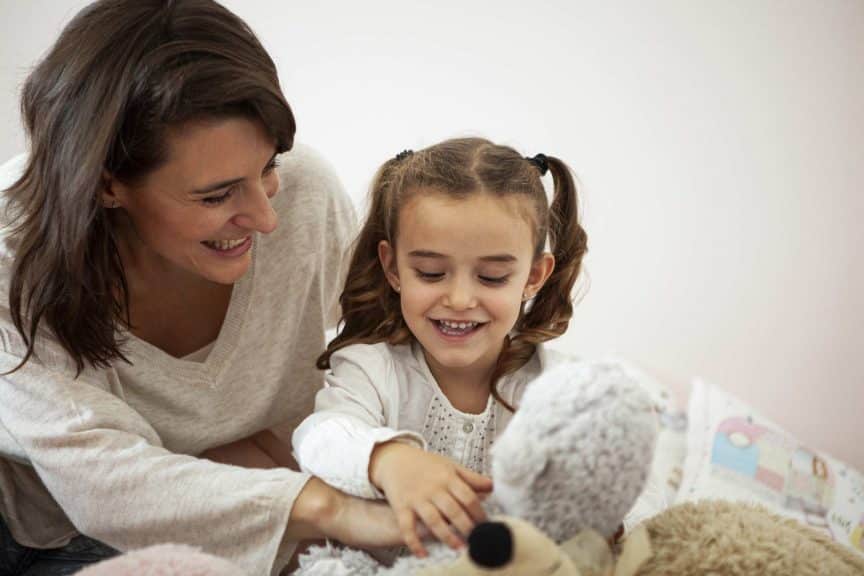We love to see children come to our classroom doors full of enthusiasm and ready for whatever is coming next! But some children reluctantly sidle up, act clingy, or are clearly anxious.
Although their negative reactions may be unrelated to being at church, it is wise to be aware of the ways we can head off some of that negativity by making each child feel welcomed.
We’ll talk about creating a welcoming place, being welcoming people, and having a welcoming program!
Ministry to children begins by welcoming them.
A Welcoming Place
Take time to look thoughtfully at the areas of your church where children’s ministries take place. Then consider the places in your town where children love to gather. What are those places? What features of those places send the message to kids that, “This place is for you. It was especially created to make you want to come here!”
In addition, consider what features are designed to actually appeal to adults, so they want to bring their kids!
Based on features that have genuine child appeal, look at your children’s ministry area again. Ask, “If we could make this place more kid friendly, how would it change? What features could it incorporate? What might this physical space look like?”
Changes need not be cutesy or especially appealing to adults. The space may not need to be a particular color or have special lights or fog machines. But it is important that the features of the room tell a child, “This place is for you because we think you are important. We welcome you into this place!”
Think about this specifically for creating a room for your program for children with special needs too!
Welcoming People

The first moments of a child’s experience at church will have great impact—for better or for worse. When a child comes to the door of a room whose interior looks like a famous pizza restaurant or an amusement park, and he or she seems overwhelmed and hesitant, we may wonder, What is wrong? Didn’t we make it look welcoming?
But if a child is ignored at the doorway of an attractive room, this tells the child that no matter how much fun this place looks, he or she is not likely to be treated as an individual. “You can be part of this gang if you are bold enough to step inside!” is what the environment alone can tell a child.
No matter how visually appealing and exciting a place may look, children are still human beings. They look for other people to whom they can relate, whether in a nursery or a preteen hangout room!
Ministry to children begins by welcoming them. Making children feel welcomed and comfortable is life-changing stuff! A friendly person at the door sees a child. He or she gets at the child’s eye level, smiles, gives a pat or hug around the shoulder, and talks to the child, repeating the child’s name.
This amazing person then explains the activities in which the child may engage. Something powerful happens—a child is included! Community is created there and then! Greeters should work in teams so that one may always be at the door while another guides a child to an appropriate area.
Making children feel welcomed and comfortable is life-changing stuff!
Even in very small classes, greeters at the door free the teachers to interact with children already in the room. Instead of being constantly distracted, teachers and children can integrate new arrivals easily and effectively. And don’t forget to give greeters the honor they deserve—they are tremendously important! Get job ideas for roles like this one in this article.


Welcoming Programs
The program is what a child experiences once he or she is inside the door. It may be large group or small group, entertaining or interactive, quiet or loud. But what makes a program say, “Welcome!” to a child? What program makes a child feel, “They value me here. They care about me. They think I can do things!”
Below are three questions to ask about a program. You can find more evaluation questions here!
1. Is the program age appropriate?
For example: Second graders yawn and roll in their seats, counting ceiling tiles during a program that is absolutely riveting the attention of the fifth graders.
Are the second graders feeling that the adults chose this program especially for them? Not at all!
Rather, they are exhibiting normal signs of restlessness that result from a program that is not designed in an age-appropriate way. You can read more about effective learning for children here.
2. Is the program different from what kids do at school?
When a program seems like school, children quickly revert to school behavior (that skill we all learn—feigning attention while ignoring the proceedings around us!). Most children believe that if they wait quietly and patiently and don’t volunteer (what some schoolteachers call “being good”), they can wait out this experience too. So, a program needs to catch children’s interest, engage their minds and bodies to tell them, “This is not school!”
However, this does not mean that a program needs to scream FUN every minute. Children are already distracted and over-entertained. We do them a disservice if we do not provide the meat of what matters forever and show them how to chew on it!

Children need some quiet time and a safe place for age-appropriate, interactive discussion that helps them not only learn Bible facts but also to understand how Bible truths work out in their own daily lives. Fun is not the only purpose of children’s ministry—because God did not create us with a need for perpetual fun but with a need for relationship with Him!
No amount of fun will satisfy that need. Fun is often the by-product of activities that engage and excite children about what matters!
Rather than asking if a program is fun, determine whether a program is lively, engaging, interesting, and conducive to children’s discovering truth for themselves. Refuse to be intimidated by those who whine, “This is boring!” Determine what their actual concerns are. Then address those concerns by involving those children in the learning process!
Rather than asking if a program is fun, determine whether a program is lively, engaging, interesting, and conducive to children’s discovering truth for themselves.
3. Is the program going to make a difference in children’s lives?
First, understand the aims and goals of the program itself. List aims you believe should be achieved in your situation. Without knowing specific aims for how a program may effect change, there will not be clarity about what result to expect!
Because this is spiritual ministry to children, don’t settle for childcare or entertainment. Talk with and listen to teachers to see if they feel the aims of the program are being met.
…
No room will be perfect. No one program will fit all needs. Not every child will care if he or she is greeted at the door. But when we create a welcoming place, we remind ourselves that we need to honor the children whom we want to disciple into wholehearted followers of Jesus Christ.
And as we honor them, we honor the One who said, “Let the little children come to me!”(Matthew 19:14).










